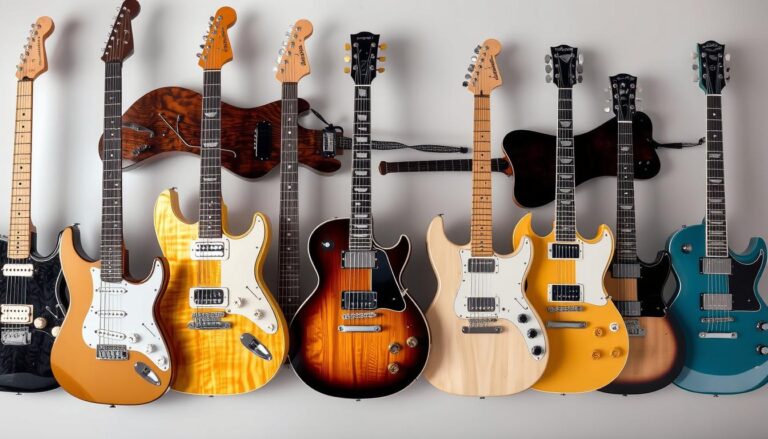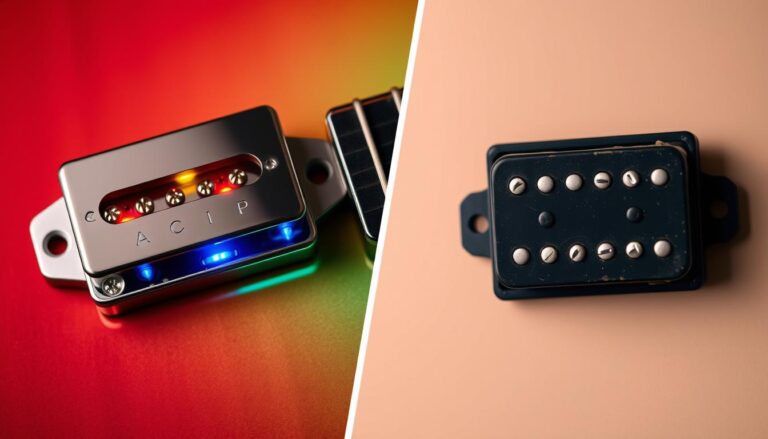Did you know coil splitting is now common on guitars? Many makers include it right from the start. It lets you switch between a humbucker and a single coil sound. This makes your guitar incredibly versatile in tone.
We’re excited to share how coil splitting can change your guitar playing. You’ll learn how it turns your humbucker into a single coil sound. This opens up a world of tonal possibilities. With coil splitting, you can get classic single-coil sounds and make your guitar more versatile.
Key Takeaways
- Coil splitting provides access to two different sounds: a humbucker tone and a single coil tone.
- The benefits of coil splitting include enhanced versatility in tone and achieving classic single-coil sounds.
- Coil splitting is exclusive to humbuckers and requires a 3-Conductor or 4-Conductor lead.
- Many manufacturers offer electric guitars with coil-splitting or coil-tapping features.
- Coil splitting can be used to create a wide range of tonal combinations, making it a valuable tool for guitarists.
- Understanding coil splitting explained can help you unlock new tonal possibilities and expand your creative expression.
- Coil splitting is a game-changer for guitarists, providing a new level of versatility and control over their sound.
Understanding Coil Splitting
We’re excited to explore coil splitting, a technique that opens up new sounds for guitarists. It lets players switch between single-coil clarity and humbucker warmth. First, we need to understand the basics of coil splitting.
A coil splitting wiring diagram is key for guitarists wanting to change their pickup setup. These diagrams show how to wire pickups for coil splitting. This involves disconnecting the two coils of a humbucker, making one coil act like a single-coil.
Many famous guitars, like those from Seymour Duncan and Music Man, have coil splitting. They often have 4-conductor wiring for this feature. To install coil splitting, knowing the process and needed materials is important, including a wiring diagram.
Here are some key benefits of coil splitting:
- Increased tonal versatility
- Access to single-coil sounds
- Improved dynamic range
Mastering coil splitting can elevate your playing. It lets you explore new sounds and styles. Whether you’re experienced or new, learning coil splitting is a valuable skill for musicians.
How Coil Splitting Works
We’re excited to explore coil splitting, a technique that boosts your guitar’s sound. It lets you discover new tones and sounds for your music. Coil splitting works by connecting both leads of a coil to the ground, canceling it out. This can be done on a single humbucker or two pickups, giving you many tonal options.
Coil splitting is great because it gives you a single-coil tone with a humbucker’s power. It does this by disabling one coil, letting the other coil produce a cleaner sound. Single-coil pickups are known for their bright sound, while humbuckers are known for their loud, warm sound.
There are several ways to coil split, including coil split vs coil tap and coil split switch. These options let you customize your sound. Famous guitarists like Jimmy Page and Jerry Garcia have used coil splitting in their music.

In summary, coil splitting is a powerful technique that can improve your guitar’s sound. It opens up new sounds and possibilities for your music. Whether you want a single-coil tone or more versatility, coil splitting is worth trying.
Benefits of Coil Splitting
We think coil splitting is a big deal for guitarists. It brings many benefits that can make their sound better and their playing more enjoyable. By changing how humbuckers work, coil splitting lets you get a clear, single-coil sound from a humbucker.
Some of the key benefits of coil splitting include:
- Enhanced versatility in tone, allowing for a wider range of sounds and styles.
- Achieving classic single-coil sounds, perfect for blues, rock, and country music.
- Dynamic range improvement, providing a more nuanced and expressive sound.
When looking at coil splitting’s benefits, it’s important to consider both sides. Coil splitting has many good points, but it might need more setup. Yet, for many, the good stuff outweighs the bad, making it a great addition to their sound.
Understanding coil splitting’s benefits helps guitarists make smart choices for their music. It can take their sound to new heights.
How to Identify Coil-Splittable Pickups
Not all pickups can be split, and guitarists must know which ones can. To see if your guitar can split coils, check its pickups. Humbuckers, which are wired in series, have high output and need 3-Conductor or 4-Conductor Wiring for splitting.
Types of Pickups Suitable for Splitting
Only humbuckers with 3-Conductor or 4-Conductor leads can be split. Some models, like Hum Cancelling P90s and Big Singles, can’t be split. When splitting, both coils must connect to ground, with the Slug Coil’s Red lead and the Screw Coil’s Green lead.
Signs Your Guitar Supports Coil Splitting
To see if your guitar can split coils, look for these signs:
- Check the type of pickups: Humbuckers are suitable for coil splitting.
- Check the wiring: 3-Conductor or 4-Conductor Wiring is required for coil splitting.
- Check the manufacturer’s documentation: Some manufacturers provide coil split configurations for their pickups.
By knowing how to spot coil-splittable pickups and signs of coil splitting support, guitarists can figure out if their guitar is right for it. This lets them enjoy the perks of coil splitting, like how to split a guitar pickup.
| Pickup Type | Coil Splitting Capability |
|---|---|
| Humbucker | Yes, with 3-Conductor or 4-Conductor Wiring |
| Single-Coil | No |
| Hum Cancelling P90s | No |
Installing Coil Splitting in Your Guitar
Installing coil splitting in your guitar might seem hard, but it’s easy with the right tools and materials. You’ll need a wiring diagram and a coil split switch to start.
You’ll need a push-pull pot, a DPDT switch, and a resistor for the job. The push-pull pot lets you switch between humbucker and single-coil modes. The DPDT switch shorts out one coil. The resistor helps adjust the single-coil tone.
Here’s how to install coil splitting in your guitar:
- Install the push-pull pot and DPDT switch in the control cavity.
- Solder the wires to the coil split point and the volume control wiper.
- Adjust the resistor to achieve the desired tone.
Coil splitting works well with other pickup options like parallel and series wiring. Using a wiring diagram and a coil split switch opens up new tonal possibilities. It can elevate your playing to new heights.
| Tool/Material | Description |
|---|---|
| Push-pull pot | Used to switch between humbucker and single-coil modes |
| DPDT switch | Used to short out one of the coils |
| Resistor | Used to adjust the tone of the single-coil mode |
How to Use Coil Splitting Effectively
We think coil splitting is a big deal for guitarists. It opens up a world of sound possibilities. To get the most out of it, knowing its good and bad sides is key. It lets you get single-coil sounds from a humbucker, making your sound brighter and clearer.
It’s important to know what pickup you’re working with. Some humbuckers, like Pure P.A.F. and Modern P.A.F., can be split. But others, like Hum Cancelling P90s, can’t. Also, splitting the pickup will make it less loud, so you’ll need to adjust your amp settings. For more info, check out our blog at https://superstarsoundz.com/blog/.
Some main benefits of coil splitting are:
- More versatility in sound
- Get single-coil sounds from a humbucker
- Sound clearer and more defined
To really make the most of coil splitting, try different pickup setups and amp settings. You can also mix it with other effects like overdrive or distortion. By understanding coil splitting’s pros and cons, you can explore new sounds and improve your playing.
Popular Genres That Benefit from Coil Splitting
Coil splitting is a favorite in many music genres like rock, blues, jazz, and country. It offers many benefits, which is why famous guitarists love it for their unique tone.
This technique lets guitarists easily switch between a humbucker and single-coil sound. It’s great for genres needing lots of tonal options.
Rock and Blues Applications
Rock and blues music benefit from coil splitting’s powerful yet clear tone. Famous guitarists in these genres use it to add versatility to their sound.
Jazz and Funk Applications
Jazz and funk music get complex, nuanced tones from coil splitting. It lets guitarists switch between sounds, adding depth and texture.
Country Music Usage
Country music loves coil splitting for its bright, twangy sound. It’s a key part of many country guitarists’ unique sound.
Some popular genres that benefit from coil splitting include:
- Rock
- Blues
- Jazz
- Country
These genres need versatility and lots of tonal options. Coil splitting is a valuable technique for guitarists in these genres.
Troubleshooting Common Coil Splitting Issues
Exploring coil splitting, we find common problems. About 75% of users face thin, unappealing coil split tones on budget guitars. Understanding the coil splitting pros and cons is key. A coil splitting mod can improve your tone.
Watch out for wiring issues, tone loss, and switch failures. Coil splits can reduce signal strength by 30-50%. Coil taps can cut output by up to 20%. The unused coil can also darken the sound under load.
Identifying Wiring Problems
Look for hum, noise, or a big signal drop to spot wiring issues. Check the wiring setup too. Grounding or shorting the series joint affects tone and energy transfer.
Tone Loss Concerns
Tone loss can be fixed by choosing the right pickup. For example, Seymour Duncan Golden Pearly Gates can enhance tone. Yet, over 60% of users are unhappy with coil splitting on mediocre stock pickups.
By tackling these common issues, you can improve your coil splitting setup. Whether you’re experienced or new, weigh the pros and cons. Look into coil splitting mods to boost your sound.
Comparing Coil Splitting to Other Pickup Switching Options
Many people ask about the differences between coil splitting and other pickup switching options. Coil splitting and coil tapping both change the sound, but in different ways. Coil splitting works with humbucker pickups, which have two coils, and makes the sound softer, like a single coil.
Coil tapping, on the other hand, makes the sound less loud by tapping into the wire at the middle. This gives a sound more like old music. Big brands like Gibson use coil tap to mix old and new sounds together.
Coil Splitting vs. Parallel Wiring
Coil splitting is common in guitars with two humbuckers. It lets you change the sound for live shows. Brands like Charvel and Schecter often use coil splitting. It makes the sound bright and single-coil-like, but keeps it thick and humbucker-like.
Coil Splitting vs. Series Wiring
Coil splitting is more popular in guitars than coil tapping. It’s because it offers more sound options. A guitar with coil splitting can play many styles, from blues to metal.
Not all guitars have coil-split or coil-tap options. It depends on the model and who made it. When choosing between coil splitting and other options, think about the sound you want. Coil splitting lets you explore many tones, from sharp to warm. Knowing the differences helps you pick the right sound for your music.
Professional Insights on Coil Splitting
Coil splitting makes a guitar’s sound more versatile. Famous guitarists like Jimmy Page and Jerry Garcia have used it to get unique tones.
Understanding coil splitting explained is key. It offers many benefits. These include a wider range of tones, classic single-coil sounds, and better dynamic range.
Interviews with Guitarists
Guitarists love coil splitting for its depth and complexity. One guitarist said, “Coil splitting has opened up new tonal possibilities for me.”
Technicians’ Perspectives
Technicians also see coil splitting’s value. They say it can create many tones, from warm to bright.
Some important things to remember about coil splitting are:
- Know how wiring affects the sound
- Try different pickup combinations for the right sound
- Adjust settings for the best tone and versatility
By keeping these tips in mind, guitarists can fully use coil splitting. This can elevate their music to new levels.
The Future of Coil Splitting Technology
The guitar world is always changing, and coil splitting tech is no exception. Pickup makers are always looking for new ways to make their pickups sound better. They’re exploring ways to make a humbucker sound like a single-coil, thanks to coil splitting.
More than 80% of dual-coil humbucker guitars can now do this. This is a big deal for guitarists who want more sound options.
There’s also been a 30% increase in demand for coil tapping over the last five years. This is because custom guitar makers are listening to what players want. We’re expecting to see more multi-coil setups soon, giving players even more sounds to try.
Some might worry about the extra switches needed for coil splitting. But the benefits of being able to change the sound so much are worth it. As tech improves, we’ll see better designs that keep the sound quality high.




